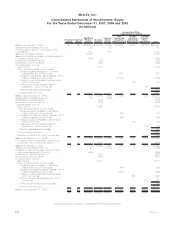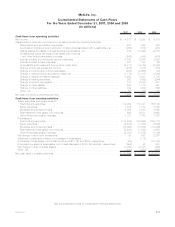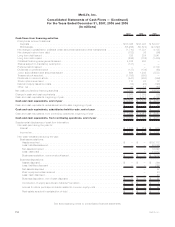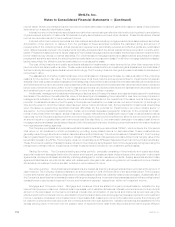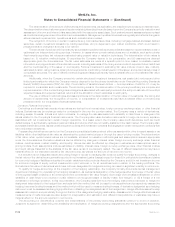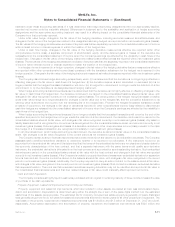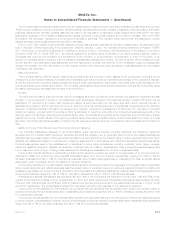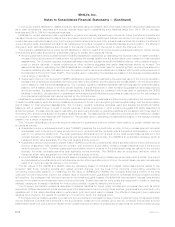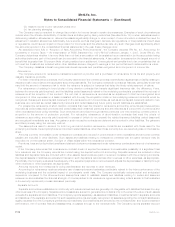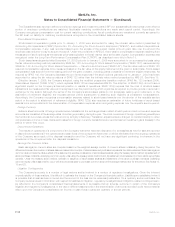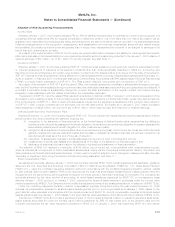MetLife 2007 Annual Report Download - page 107
Download and view the complete annual report
Please find page 107 of the 2007 MetLife annual report below. You can navigate through the pages in the report by either clicking on the pages listed below, or by using the keyword search tool below to find specific information within the annual report.treatment under these accounting standards. If it was determined that hedge accounting designations were not appropriately applied,
reported net income could be materially affected. Differences in judgment as to the availability and application of hedge accounting
designations and the appropriate accounting treatment may result in a differing impact on the consolidated financial statements of the
Company from that previously reported.
Under a fair value hedge, changes in the fair value of the hedging derivative, including amounts measured as ineffectiveness, and
changes in the fair value of the hedged item related to the designated risk being hedged, are reported within net investment gains (losses).
The fair values of the hedging derivatives are exclusive of any accruals that are separately reported in the consolidated statement of income
within interest income or interest expense to match the location of the hedged item.
Under a cash flow hedge, changes in the fair value of the hedging derivative measured as effective are reported within other
comprehensive income (loss), a separate component of stockholders’ equity, and the deferred gains or losses on the derivative are
reclassified into the consolidated statement of income when the Company’s earnings are affected by the variability in cash flows of the
hedged item. Changes in the fair value of the hedging instrument measured as ineffectiveness are reported within net investment gains
(losses). The fair values of the hedging derivatives are exclusive of any accruals that are separately reported in the consolidated statement
of income within interest income or interest expense to match the location of the hedged item.
In a hedge of a net investment in a foreign operation, changes in the fair value of the hedging derivative that are measured as effective
are reported within other comprehensive income (loss) consistent with the translation adjustment for the hedged net investment in the
foreign operation. Changes in the fair value of the hedging instrument measured as ineffectiveness are reported within net investment gains
(losses).
The Company discontinues hedge accounting prospectively when: (i) it is determined that the derivative is no longer highly effective in
offsetting changes in the fair value or cash flows of a hedged item; (ii) the derivative expires, is sold, terminated, or exercised; (iii) it is no
longer probable that the hedged forecasted transaction will occur; (iv) a hedged firm commitment no longermeetsthedefinitionofafirm
commitment; or (v) the derivative is de-designated as a hedging instrument.
When hedge accounting is discontinued because it is determined that the derivative is not highly effective in offsetting changes in the
fair value or cash flows of a hedged item, the derivative continues to be carried on the consolidated balance sheet at its fair value, with
changes in fair value recognized currently in net investment gains (losses). The carrying value of the hedged recognized asset or liability
under a fair value hedge is no longer adjusted for changes in its fair value due to the hedged risk, and the cumulative adjustment to its
carrying value is amortized into income over the remaining life of the hedged item. Provided the hedged forecasted transaction is still
probable of occurrence, the changes in fair value of derivatives recorded in other comprehensive income (loss) related to discontinued
cash flow hedges are released into the consolidated statement of income when the Company’s earnings are affected by the variability in
cash flows of the hedged item.
When hedge accounting is discontinued because it is no longer probable that the forecasted transactions will occur by the end of the
specified time period or the hedged item no longer meets the definition of a firm commitment, the derivative continues to be carried on the
consolidated balance sheet at its fair value, with changes in fair value recognized currently in net investment gains (losses). Any asset or
liability associated with a recognized firm commitment is derecognized from the consolidated balance sheet, and recorded currently in net
investment gains (losses). Deferred gains and losses of a derivative recorded in other comprehensive income (loss) pursuant to the cash
flow hedge of a forecasted transaction are recognized immediately in net investment gains (losses).
In all other situations in which hedge accounting is discontinued, the derivative is carried at its fair value on the consolidated balance
sheet, with changes in its fair value recognized in the current period as net investment gains (losses).
The Company is also a party to financial instruments that contain terms which are deemed to be embedded derivatives. The Company
assesses each identified embedded derivative to determine whether it is required to be bifurcated. If the instrument would not be
accounted for in its entirety at fair value and it is determined that the terms of the embedded derivative are not clearly and closely related to
the economic characteristics of the host contract, and that a separate instrument with the same terms would qualify as a derivative
instrument, the embedded derivative is bifurcated from the host contract and accounted for as a freestanding derivative. Such embedded
derivatives are carried on the consolidated balance sheet at fair value with the host contract and changes in their fair value are reported
currently in net investment gains (losses). If the Company is unable to properly identify and measure an embedded derivative for separation
from its host contract, the entire contract is carried on the balance sheet at fair value, with changes in fair value recognized in the current
period in net investment gains (losses). Additionally, the Company may elect to carry an entire contract on the balance sheet at fair value,
with changes in fair value recognized in the current period in net investment gains (losses) if that contract contains an embedded derivative
that requires bifurcation. There is a risk that embedded derivatives requiring bifurcation may not be identified and reported at fair value in
the consolidated financial statements and that their related changes in fair value could materially affect reported net income.
Cash and Cash Equivalents
The Company considers all highly liquid investments purchased with an original or remaining maturity of three months or less at the date
of purchase to be cash equivalents.
Property, Equipment, Leasehold Improvements and Computer Software
Property, equipment and leasehold improvements, which are included in other assets, are stated at cost, less accumulated depre-
ciation and amortization. Depreciation is determined using either the straight-line or sum-of-the-years-digits method over the estimated
useful lives of the assets, as appropriate. The estimated life for company occupied real estate property is generally 40 years. Estimated
lives generally range from five to ten years for leasehold improvements and three to seven years for all other property and equipment. The
cost basis of the property, equipment and leasehold improvements was $1.6 billion and $1.5 billion at December 31, 2007 and 2006,
respectively. Accumulated depreciation and amortization of property, equipment and leasehold improvements was $828 million and
F-11MetLife, Inc.
MetLife, Inc.
Notes to Consolidated Financial Statements — (Continued)





